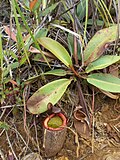Paleopolyploidy is the result of genome duplications which occurred at least several million years ago (MYA). Such an event could either double the genome...
28 KB (3,098 words) - 12:10, 28 June 2024
Polyploidy (section Paleopolyploidy)
origin of the teleost fishes. Angiosperms (flowering plants) have paleopolyploidy in their ancestry. All eukaryotes probably have experienced a polyploidy...
81 KB (8,829 words) - 02:44, 15 July 2024
whole genome duplications, and thus modern vertebrate genomes reflect paleopolyploidy. The name derives from the 2 rounds of duplication originally hypothesized...
19 KB (2,193 words) - 10:43, 29 May 2024
translocation Numerical alterations Aneuploidy Euploidy Polyploidy Paleopolyploidy Polyploidization Structures Telomere: Telomere-binding protein (TINF2)...
19 KB (1,931 words) - 14:44, 13 May 2024
(bowfin and gars) in having gone through a whole-genome duplication (paleopolyploidy). The WGD is estimated to have happened about 320 million years ago...
48 KB (3,773 words) - 15:43, 26 June 2024
history. See paleopolyploidy. In many cases, these events can be inferred only through comparing sequenced genomes. Angiosperms have paleopolyploidy in their...
16 KB (1,784 words) - 09:44, 9 April 2024
Paleogene, Paleolithic, paleology, paleomagnetism, paleontology, paleopolyploidy, paleopsychology, Paleozoic palin-, palim- back Greek πάλιν (pálin)...
2 KB (1,764 words) - 06:15, 16 April 2024
translocation Numerical alterations Aneuploidy Euploidy Polyploidy Paleopolyploidy Polyploidization Structures Telomere: Telomere-binding protein (TINF2)...
8 KB (586 words) - 20:00, 24 October 2023
hypothesized that vertebrate genomes have gone through two rounds of paleopolyploidy. The mechanisms of diploidization are poorly understood but patterns...
8 KB (1,006 words) - 08:48, 20 April 2024
chromosome number of 2n=80. This high number is thought to reflect paleopolyploidy (likely 8x or 16x). About 170 species of Nepenthes are currently recognised...
64 KB (6,973 words) - 17:00, 24 May 2024





